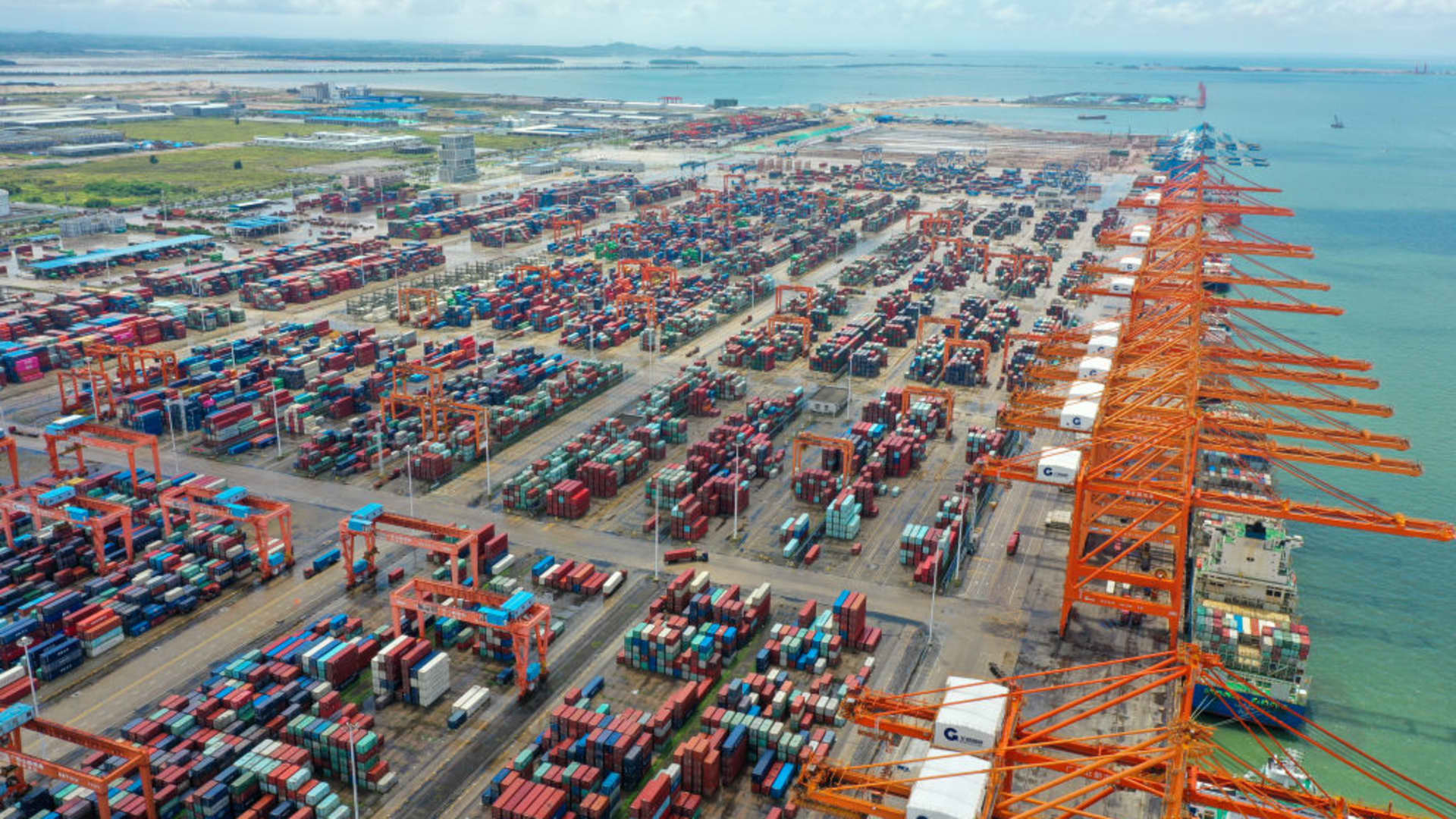
Aerial view of containers sitting stacked at the Qinzhou Port on August 15, 2022 in Qinzhou, Guangxi Zhuang Autonomous Region of China.
China News Service | Getty Images
U.S. logistic managers are bracing for delays in the delivery of goods from China in early January as a result of canceled sailings of container ships and rollovers of exports by ocean carriers.
Carriers have been executing on an active capacity management strategy by announcing more blank sailings and suspending services to balance supply with demand. “The unrelenting decline in container freight rates from Asia, caused by a collapse in demand, is compelling ocean carriers to blank more sailings than ever before as vessel utilization hits new lows,” said Joe Monaghan, CEO of Worldwide Logistics Group.
U.S. manufacturing orders in China are down 40 percent, according to the latest CNBC Supply Chain Heat Map data. As a result of the decrease in orders, Worldwide Logistics tells CNBC it is expecting Chinese factories to shut down two weeks earlier than usual for the Chinese Lunar New Year — Chinese New Year’s Eve falls on Jan. 21 next year. The seven days after the holiday are considered a national holiday.
“Many of the manufacturers will be closed in early January for the holiday, which is much earlier than last year,” Monaghan said.
Supply chain research firm Project44 tells CNBC that after reaching record-breaking levels of trade during the pandemic lockdowns, vessel TEU (twenty-foot equivalent unit) volume from China to the U.S. has significantly pulled back since the end of summer 2022 — including a decline of 21% in total vessel container volume between August and November.
Asia-based global shipping firm HLS warned clients in a recent communication about the ocean transport business climate.
“It seems to be a very bad time for the shipping industry. We have the combination of declining demands and overcapacity as new tonnage enters the market,” it wrote.
HLS analysts are predicting a further 2.5% decline in container volumes and a nearly 5-6% increase in capacity in 2023, which will continue to negatively impact freight rates in 2023.
“The container shipping market will be further complicated by economic uncertainty, geopolitical concerns, and also the increasingly heated market competition,” HLS wrote.
OL USA CEO Alan Baer tells CNBC that there are some early signs of an inventory correction. Overall business volume and order flow out of Asia continue to be muted as carriers cancel more vessels, and there is little upside momentum leading into Chinese New Year. But Baer said, “Space has already tightened, so while demand is soft, space may be at a premium in January and throughout Q1. On the plus side, inventory depletion and the need to restart the order and delivery cycle appears to be inching upward.”
U.S. West Coast ports take biggest hit
HLS cited trade data showing that U.S. imports from Asia plunged in October to their lowest level in 20 months. The spot rate for a container from Asia to the U.S. West Coast has crossed the breakeven point, “with little room for further reductions,” it wrote.
The large West Coast ports of Los Angeles and Long Beach have experienced the largest drop in trade, according to Josh Brazil, vice president of supply chain insights at Project44, as shippers also rerouted some of their shipments to the East Coast to avoid the risk of a major union strike at West Coast ports.
HLS expects most carriers to extend their West Coast rates until December 14, holding at $1,300-$1,400 per forty-foot equivalent containers (FEU). However, U.S. East Coast rates are expected to drop by $200 or $300 to average $3,200-3,300 per FEU in the first half of December.
The recent rise in Covid lockdowns in China continues to impact manufacturing operations and delay cargo outputs. There are also local access obstacles for cross-province and cross-city transportation, mostly related to truck driver testing requirements, with trucking capacity to be largely affected.
The fight for vessel space, the rollovers of cargo, and the slow trucking is tracked by the CNBC Supply Chain Heat Map.
Blank (canceled) sailings data shows the cut in vessel capacity on the transpacific route (China to the U.S.) continues at a significant pace. The 2M Alliance of Maersk and MSC has suspended almost half of its U.S. West Coast services for December. The Ocean Alliance (CMA CGM, Cosco Shipping, OOCL and Evergreen) and THE Alliance (Ocean Network Express, Hapag-Lloyd, HMM and Yang Ming Line) have cut overall vessel capacity by 40-50% up to Chinese New Year.
As a result, space for shippers is considered tight for cargo bound for the Pacific Southwest route and service reliability has declined, with carriers including MSC and Hapag-Lloyd rolling (not accepting) cargo on sailings in an effort to make up time. According to logistics managers, this is creating two weeks of delay. MSC said in its latest notice to clients, “ETAs are indicative and subject to change without prior notice.”

The drop in manufacturing orders from the U.S. and the E.U. is also impacting Vietnam, which has been booming as a manufacturing hub as more trade moved away from China.
Since early this year, 12,500 companies were closed per month, a 24.8% increase year over year, according to the Vietnam General Statistics Office report. The combination of the lack of manufacturing orders and loan interest rates increasing from 6.5% to 13.2% in Vietnam led many companies to close factories instead of signing new order contracts, according to HLS. Canceled ocean sailings bound for Vietnam are up 50% for December.
Surprise European manufacturing increase
Unlike the decrease in orders out of China, trade data analyzed by Project44 indicates that the Europe-to-U.S. route is “one of the possibly most surprising and certainly most significant developments since early 2020,” Brazil said.
“This sharp rise cannot be explained by the pandemic alone. But a strategic shift from over-dependency on trade with China and geopolitical tensions over Russia are the main drivers of the EU-U.S. trade boom,” he said.
The global trading map is being rapidly redrawn, with EU-U.S. trade and investment in U.S. rising sharply as economic ties between the West and China are subjected to critical scrutiny. This year, the U.S. has imported more goods from Europe than China – a big shift from the 2010s, according to Project 44.
“For their part, Europe’s manufacturers battling sky-high energy prices and inflation are increasingly exporting to and investing in the U.S.,” Brazil said.
Germany’s exports to the U.S. were almost 50% higher in September year over year. Germany’s mechanical engineering sector has boosted its exports to the U.S. by almost 20% in a year over year comparison of the first nine months of 2022, according to Project 44.
The CNBC Supply Chain Heat Map data providers are artificial intelligence and predictive analytics company Everstream Analytics; global freight booking platform Freightos, creator of the Freightos Baltic Dry Index; logistics provider OL USA; supply chain intelligence platform FreightWaves; supply chain platform Blume Global; third-party logistics provider Orient Star Group; global maritime analytics provider MarineTraffic; maritime visibility data company Project44; maritime transport data company MDS Transmodal UK; ocean and air freight rate benchmarking and market analytics platform Xeneta; leading provider of research and analysis Sea-Intelligence ApS; Crane Worldwide Logistics; DHL Global Forwarding; freight logistics provider Seko Logistics; Planet, provider of global, daily satellite imagery and geospatial solutions, and ITS Logistics provides port and rail drayage services in 22 coastal ports and 30 rail ramps throughout North America.
